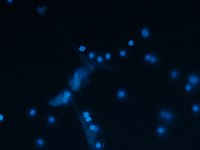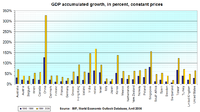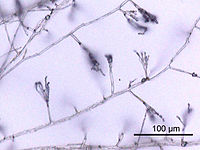
Oxidative damage of SP‐D abolishes control of eosinophil extracellular DNA trap formation
Sign Up to like & getrecommendations! Published in 2018 at "Journal of Leukocyte Biology"
DOI: 10.1002/jlb.3ab1117-455r
Abstract: The asthmatic airways are highly susceptible to inflammatory injury by air pollutants such as ozone (O3), characterized by enhanced activation of eosinophilic granulocytes and a failure of immune protective mechanisms. Eosinophil activation during asthma exacerbation… read more here.
Keywords: dna trap; trap formation; extracellular dna; dna ... See more keywords

AoStuA, an APSES transcription factor, regulates the conidiation, trap formation, stress resistance, and pathogenicity of the nematode-trapping fungus Arthrobotrys oligospora.
Sign Up to like & getrecommendations! Published in 2019 at "Environmental microbiology"
DOI: 10.1111/1462-2920.14785
Abstract: The APSES protein family comprises a conserved class of fungus-specific transcriptional regulators. Some members have been identified in partial ascomycetes. In this study, the APSES protein StuA (AoStuA) of the nematode-trapping fungus Arthrobotrys oligospora was… read more here.
Keywords: trap formation; nematode trapping; trapping fungus; fungus arthrobotrys ... See more keywords

Peroxin Pex14/17 Is Required for Trap Formation, and Plays Pleiotropic Roles in Mycelial Development, Stress Response, and Secondary Metabolism in Arthrobotrys oligospora
Sign Up to like & getrecommendations! Published in 2023 at "mSphere"
DOI: 10.1128/msphere.00012-23
Abstract: Peroxisome biogenesis genes (PEX) play an important role in growth, development, and pathogenicity in pathogenic fungi. However, the roles of PEX genes remain largely unknown in nematode-trapping (NT) fungi. ABSTRACT The peroxins encoded by PEX… read more here.
Keywords: growth; development; trap formation; metabolism ... See more keywords

AoPEX1 and AoPEX6 Are Required for Mycelial Growth, Conidiation, Stress Response, Fatty Acid Utilization, and Trap Formation in Arthrobotrys oligospora
Sign Up to like & getrecommendations! Published in 2022 at "Microbiology Spectrum"
DOI: 10.1128/spectrum.00275-22
Abstract: Nematode-trapping (NT) fungi are important resources for the biological control of plant-parasitic nematodes. They are widely distributed in various ecological environments and capture nematodes by producing unique predatory organs (traps). ABSTRACT Arthrobotrys oligospora (A. oligospora)… read more here.
Keywords: formation; mycelial growth; trap formation; aopex1 aopex6 ... See more keywords

Intercellular communication is required for trap formation in the nematode-trapping fungus Duddingtonia flagrans
Sign Up to like & getrecommendations! Published in 2019 at "PLoS Genetics"
DOI: 10.1371/journal.pgen.1008029
Abstract: Nematode-trapping fungi (NTF) are a large and diverse group of fungi, which may switch from a saprotrophic to a predatory lifestyle if nematodes are present. Different fungi have developed different trapping devices, ranging from adhesive… read more here.
Keywords: communication required; communication; trap formation; nematode trapping ... See more keywords

AoSsk1, a Response Regulator Required for Mycelial Growth and Development, Stress Responses, Trap Formation, and the Secondary Metabolism in Arthrobotrys oligospora
Sign Up to like & getrecommendations! Published in 2022 at "Journal of Fungi"
DOI: 10.3390/jof8030260
Abstract: Ssk1, a response regulator of the two-component signaling system, plays an important role in the cellular response to hyperosmotic stress in fungi. Herein, an ortholog of ssk1 (Aossk1) was characterized in the nematode-trapping fungus Arthrobotrys… read more here.
Keywords: stress; trap formation; response regulator;

Regulatory Mechanism of Trap Formation in the Nematode-Trapping Fungi
Sign Up to like & getrecommendations! Published in 2022 at "Journal of Fungi"
DOI: 10.3390/jof8040406
Abstract: Nematode-trapping (NT) fungi play a significant role in the biological control of plant- parasitic nematodes. NT fungi, as a predator, can differentiate into specialized structures called “traps” to capture, kill, and consume nematodes at a… read more here.
Keywords: trap formation; nematode trapping; mechanism trap; formation ... See more keywords

Functional Analysis of Two Affinity cAMP Phosphodiesterases in the Nematode-Trapping Fungus Arthrobotrys oligospora
Sign Up to like & getrecommendations! Published in 2022 at "Pathogens"
DOI: 10.3390/pathogens11040405
Abstract: Phosphodiesterases are essential regulators of cyclic nucleotide signaling with diverse physiological functions. Two phosphodiesterases, PdeH and PdeL, have been identified from yeast and filamentous fungi. Here, the orthologs of PdeH and PdeL were characterized in… read more here.
Keywords: trap formation; trapping fungus; nematode trapping; fungus arthrobotrys ... See more keywords

Amphiphysin AoRvs167-Mediated Membrane Curvature Facilitates Trap Formation, Endocytosis, and Stress Resistance in Arthrobotrys oligospora
Sign Up to like & getrecommendations! Published in 2022 at "Pathogens"
DOI: 10.3390/pathogens11090997
Abstract: Bin1/Amphiphysin/Rvs (BAR) domain-containing proteins mediate fundamental cellular processes, including membrane remodeling and endocytosis. Nematode-trapping (NT) fungi can differentiate to form trapping structures through highly reorganized cell membranes and walls. In this study, we identified the… read more here.
Keywords: aorvs167; endocytosis; trap formation; arthrobotrys oligospora ... See more keywords